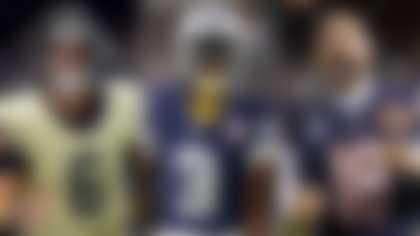I love win totals, and these are the best I've got.
In order to create season-long win totals, I take data from the past 10 NFL campaigns and use it to forecast this year's outcomes. I make a model that takes into account trends, personnel and situations that were proven to lead to wins (or losses) in the past. Then I "play out the season" 320,000 times. Yes, it's kind of like "Madden" simulations. Yes, it adapts each year to account for the game's evolution. And yes, I am aware no team is winning 8.2 games ...
... but the reason our game is the best is the same reason we need fractions: parity. There are only 256 total regular-season games and there should be more 8-8 results. Look at the NFC East, where a team hasn't won the division in consecutive years since 2004! So, take it for what it's worth: relative value. Then look to see how big the ceiling-to-floor range is -- if it's big, that means a team is projected for more close games.
One cool side note: The whole NFC forecasts to be incredibly competitive this year, with 14 teams having the same combined chances of making the playoffs as the top seven in the AFC.
You'll find win totals for every NFC team below.
Arizona Cardinals: 5.5 wins
Ceiling: 6.3
Floor: 3.7
David Johnson is unquestionably Arizona's offensive motor. With the stud running back leading the way in 2016, the Cardinals ranked third in total first downs gained. Last season, when Johnson was lost on opening day? Arizona plummeted to 17th. Still, even with the return of this scrimmage-yards monster, the Cards have offensive concerns. Questions at quarterback and receiver (NOTE: notLarry Fitzgerald, but the rest of the pass catchers) mean this offense projects to rank in the bottom third in total yards and touchdowns, according to my model.
Atlanta Falcons: 7.5 wins
Ceiling: 8.9
Floor: 6.7
The Falcons should look more like the team from 2016 than 2017, due to the addition of first-round wideout Calvin Ridley, who is poised to demand the kind of attention from defenses that will open up more options in Atlanta's passing game and help disguise rushing plays. The NFC South could be a beneficiary of a very competitive NFC North, as my model indicates the latter division might cannibalize itself a bit, leaving a wild-card slot open for the rest of the conference. In other words, the Falcons have a very realistic chance of making a playoff run. So, why only 7.5 wins as the top-line number in this projection? Well, here's an honest peek behind the curtain: I am more bullish on the Falcons than this win total suggests. BUT, in order to trend toward double-digit wins, Atlanta must increase its offensive efficiency and play-calling diversity. That will come down to how well Steve Sarkisian performs in his second year running the offense.
Carolina Panthers: 7.2 wins
Ceiling: 7.7
Floor: 6.1
If this team had almost any other quarterback, the number would be a lot lower. The main red flag is the O-line. In the preseason -- and yes, I know it's the preseason -- Carolina's offensive front was pushed back and/or allowed pressure on the greatest percentage of passing downs in the NFL. The Panthers just added tackle depth by acquiring Corey Robinson in a trade with the Lions, but Robinson's a former seventh-round pick with eight career starts. In the past seven years, teams that have allowed push-back + pressures ranking in the bottom five during the regular season haven't made the playoffs once.
Chicago Bears: 8.0 wins
Ceiling: 9.9
Floor: 7.2
Before Khalil Mack was traded to the Bears, I noted that this defense seemed underrated. Last season, the unit ranked 10th in total defense and fourth in touchdowns allowed, so the arrow was already pointing up for 2018. Then, after the blockbuster trade for Mack, Chicago's win total increased by 1.6 games overnight (literally). Defensive stability will give this offense -- which ranked 30th in yards and 29th in points last year -- the support it needs to grow. If second-year QB Mitchell Trubisky can continue to develop under new head coach Matt Nagy, the Bears have a very realistic shot at the playoffs.
Dallas Cowboys: 7.4 wins
Ceiling: 8.9
Floor: 6.7
Exceptional O-lines and running backs who earn first downs at the rate Ezekiel Elliott has posted in the past (he led the league with 6.1 per game in 2016) provide stability and greater win projections -- even with a lot of questions in the passing game.
Detroit Lions: 7.3 wins
Ceiling: 8.3
Floor: 5.2
When you don't have a reliable ground attack, the bottom falls out of your projected floor. There are plenty of stats to showcase the Lions' recent ineptitude in this area (ranking dead last in 2017 with an average of 76.3 rushing yards per game is one), but the free-agent addition of LeGarrette Blount and high draft picks spent on LG Frank Ragnow (first round) and RB Kerryon Johnson (second round) signal that new head coach Matt Patricia might be scheming to change things.
Green Bay Packers: 10.2 wins (projected NFC North champions)
Ceiling: 12.0
Floor: 9.1
Without Aaron Rodgers last season, the Packers averaged 7.8 fewer points per game. Over the past three seasons, Rodgers averaged a touchdown pass on 6.1 percent of his attempts (yes, this led the league in that span). Adding Jimmy Graham, who topped the NFL with 10 red-zone touchdowns last season, will help account for the loss of Jordy Nelson. The young secondary is a source of concern -- Green Bay allowed 30 TD passes last season (tied for 29th) and a 102.0 passer rating to opposing QBs (31st) -- but Rodgers' return is a much bigger positive indicator.
Los Angeles Rams: 9.2 wins (projected NFC West champions)
Ceiling: 10.9
Floor: 8.8
The Rams led the NFL in scoring during Sean McVay's debut campaign. While I don't have them projected to average 29.9 points per game again in Jared Goff's third year, their high-potential defense means they won't need to score as much in order to win. Also, according to my calculations, no individual defender drives a greater win-total uptick than Aaron Donald (1.9 games).
Minnesota Vikings: 9.9 wins (projected wild card)
Ceiling: 11.8
Floor: 8.4
The Vikings' defense projects to finish ranked no lower than third in my model when it comes to pressures, total yards and touchdowns allowed. But between their difficult schedule and an O-line that has shown early signs of ranking poorly in push-back + pressures, there are some red flags here. Especially with a new quarterback who has experienced issues with red-zone turnovers in the past.
New Orleans Saints: 10.1 wins (projected NFC South champions)
Ceiling: 12.9
Floor: 7.9
No team has a higher projected balance of efficiency on offense and defense than the Saints, as they rank in the top five in each of the following predicted metrics: rushing average, third-down conversion rate on both sides of the ball and defensive pressures. From Oct. 21 through Nov. 22, the Saints face the Ravens and Vikings on the road, and the Rams, Eagles and Falcons at home. This stretch is the source of New Orleans' massive floor-to-ceiling range.
New York Giants: 8.003 wins (projected wild card)
Ceiling: 9.7
Floor: 7.2
Last season, New York logged the fewest big plays in the league (68 combined rushes of 10-plus yards and completions of 20-plus). But after upgrading the O-line, drafting a running back with major pass-catching upside and getting back Odell Beckham Jr., the G-Men should experience a huge uptick in big plays. My model shows early signs that the Dec. 2 home game against the Bears could be what determines who goes to the playoffs and who is left on the outside looking in.
Philadelphia Eagles: 11.7 wins (projected NFC East champions)
Ceiling: 12.1
Floor: 8.8
At the publishing of this piece, it's unclear when Carson Wentz will return. We do know Nick Foles is the Week 1 starter at home against Atlanta. That shifted the Eagles' win projection from 65.5 percent to 54.6 percent in the opener. However, this was the only game out of Philly's first four that saw the win projection decrease by more than 3 percent. (Games against the Bucs, Colts and Titans all spit out convincing win percentages, regardless of who's under center.) Efficiency and diversity of plays on offense, combined with the addition of Michael Bennett to a defensive front that already created the most pressure on opposing quarterbacks, drive this No. 1 seed in the NFC projection.
San Francisco 49ers: 7.9 wins
Ceiling: 8.8
Floor: 6.5
From 2015 through '17, San Francisco spent four first-round picks on defenders. In order for the 49ers to reach the top of their potential, they need those premium selections to provide returns on investment. Furthermore, the Niners' fourth-place schedule advantage was reduced with the trade of Khalil Mack to the Bears (one of their two unique NFC matchups).
Seattle Seahawks: 6.3 wins
Ceiling: 7.8
Floor: 4.0
This is the roster my model has the most questions about. Red flags abound, especially on defense. Essentially, the things that usually indicate what will happen in my model are the least certain for this team. Losing as many key pieces as the 'Hawks have in one year -- most notably, Jimmy Graham, Richard Sherman, Kam Chancellor, Michael Bennett and (for now) Earl Thomas -- makes predicting how they will play a lot tougher, hence the wide gap between ceiling and floor. Here's my favorite piece of good news: Russell Wilson is still elite and insulates the team with four wins on his own. And Doug Baldwin has a strong opportunity for a big year.
Tampa Bay Buccaneers: 4.1 wins
Ceiling: 4.7
Floor: 2.5
The Buccaneers have three extremely tough matchups to start the season during Jameis Winston's suspension: at Saints, vs. Eagles, vs. Steelers. One of the biggest red flags is the run game, as Tampa Bay ranked 27th last season. An inconsistent ground attack combined with Winston's style of play signals turnovers -- Tampa was tied for the sixth-most last season with 27. One positive note: The addition of Jason Pierre-Paul, among many other defenders, should help the Bucs get out of the sack cellar (SEE: a league-low 22 in 2017).
Washington Redskins: 7.7 wins
Ceiling: 8.4
Floor: 6.3
I've gone on and on about Alex Smith being an upgrade for Washington in the red zone. I've also seen this offense's run game lower the win-total floor, due to uncertainty. (Promising rookie Derrius Guice is out for the season, while Adrian Peterson is 33 years old.) What really drives a higher-than-some-expect win total? The defense. The upside comes from first-round pick Daron Payne, returning defensive end (and 2017 first-rounder) Jonathan Allen and the increase in overall health of this team. According to my projections, the improved defensive front will raise Washington from 29th in big plays allowed to 14th.
Follow Cynthia Frelund on Twitter @cfrelund.












